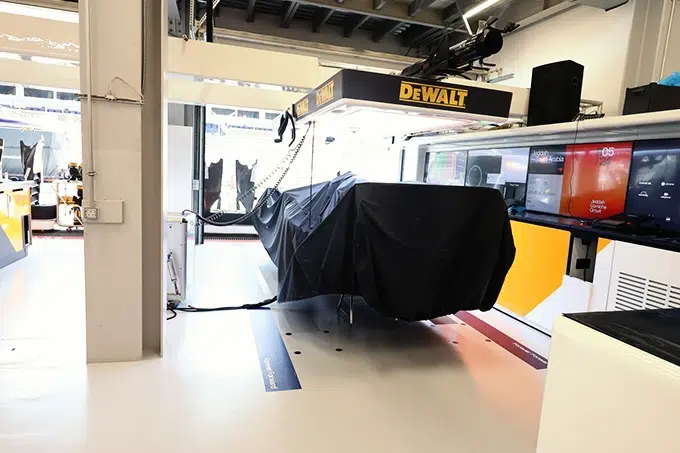As Trump’s tariffs shake global markets, F1 teams, from sponsors to suppliers, face uncertain challenges that could affect the sport’s growth in the U.S.
How much could President Trump’s erratic and difficult-to-understand protectionist push impact Formula 1 negatively?
On April 2, the U.S. president imposed higher tariffs, ranging from 11% to 50%, on goods from 57 countries. These were later suspended for all nations except China for at least 90 days, following concerns in the markets, especially in the bond sector.
Formula 1 is a global sport, and it has been expanding its footprint in the U.S. But could these “tariffs,” as President Trump refers to them, have an impact on the sport’s growth in the United States?
The global economic shockwaves (such as the drop in the dollar) are bound to affect F1, but the precise impact remains unclear.
“We’re not in the currency trading business! Honestly, for us, there hasn’t been any major impact so far,” says Peter Bayer, CEO of Racing Bulls.
“We have U.S.-based sponsors who are watching the situation closely, but we don’t expect any significant effects at the moment. There’s so much uncertainty about what will actually happen with these tariffs—whether they’ll materialize, how severe they will be, and where exactly they’ll apply. I think everyone is probably in a holding pattern, but so far, no major impact.”
Ferrari, which sells a lot of cars in the U.S., is among the manufacturers that can raise prices without much concern.
“Like Peter, we also have U.S. sponsors, and many of our suppliers are American, sometimes purchasing raw materials from China. This creates a certain level of uncertainty about the future,” comments Frédéric Vasseur.
“We’re having open discussions with them and trying to anticipate any issues. But it’s true – it could be tricky.”
Impact of the Dollar’s Decline and Export Issues on F1
James Vowles, head of Williams, elaborated on the potential consequences of the tariffs.
He explained that diversifying a team’s resources and payment currencies helps reduce exposure to risk.
“Fundamentally, a large portion of a team’s income comes from sponsors or our partners. The dollar is weak right now. So you try to hedge a little bit,” he notes.
“For example, some drivers are paid in dollars, others in euros. A portion of your partner income is in dollars, another part in euros or pounds. So you can hedge by structuring contracts differently. I’m not sure what other teams are doing, but it’s a smart approach.”
F1 teams typically get paid in dollars, particularly from TV rights paid by the FOM. With the dollar weakening while teams in the UK pay salaries in pounds, is this a potential headache for James Vowles? Or are the budget caps the main limitation for his team?
“Probably, for us, one of the largest sources of revenue is our FOM income, which is in dollars and fixed in dollars. So, has this affected our current situation? Yes, but it’s the kind of thing I don’t dwell on too much,” says Vowles.
Moreover, Williams F1’s owners, Dorilton Capital, are American. Could this introduce another vulnerability?
“I think one of the advantages of Williams is that we’re genuinely independent, and our parent company, Dorilton, is truly international in terms of revenue streams from all over the world. It doesn’t rely on any particular financial structure, which is very useful for us.”
“Right now, we’ve had internal discussions, and there’s been no major impact from the tariffs or the dollar situation. These are small numbers. It’s not helping, but they’re small numbers.”
“Big manufacturers are more affected right now because of the turbulence in who’s buying products, where they’re being purchased, and the costs involved.”
“I can’t predict what the future holds in this regard, but I can only speak for ourselves. Yes, it’s inconvenient, but it hasn’t dramatically impacted our daily operations. It hasn’t changed our budget, our forecasts for the next three years, or our investments for the next three years.”
The U.S. doesn’t supply a significant amount of material to F1 teams, but the situation could be different for Haas F1 and Cadillac.
“The amount of material supplied from the U.S. isn’t as significant as one might think,” says James Vowles. “Raw materials come from all over the world, but we deliberately hedge on this. I think COVID taught us one thing: to ensure we have suppliers based everywhere because you never know what might happen.”
“You stockpile as much as you can, but in the end, [materials] can only stay in storage for so long. But these stockpiles are already practically at the maximum comfort level because the budget cap doesn’t allow us to buy six years’ worth of supplies.”
“You have to be careful what you do in a budget-capped world to avoid overloading one year for the future. So no, we have enough to continue.”
Fighting Short-Term Thinking at Williams F1
The global economic situation hasn’t yet disrupted Williams F1’s recovery. However, as James Vowles concludes, it will take time, given the two decades of underinvestment.
“Let’s be honest, we’re in a tough spot because we’ve been short-term focused for the last 20 years. Partly for financial reasons, partly due to other factors. But you can’t be short-term focused in this sport. You need investment.”
“To be clear, the investment is projected over about five years to position ourselves as leaders.”
“It wasn’t difficult at all because one of the reasons I joined Williams F1 was that we had a very candid discussion from the outset that this would take time, that it would require investment, and that we couldn’t be driven by short-term thinking. And that was completely aligned and agreed upon from the start.”

- Discover More>Sauber F1: Wheatley Appoints Sproule for Major Shift
- Follow us on >FACEBOOK and >TWITTERfor F1 update
Trump’s Tariff War: How F1 Teams Are Impacted
Trump’s Tariff War: How F1 Teams Are Impacted
